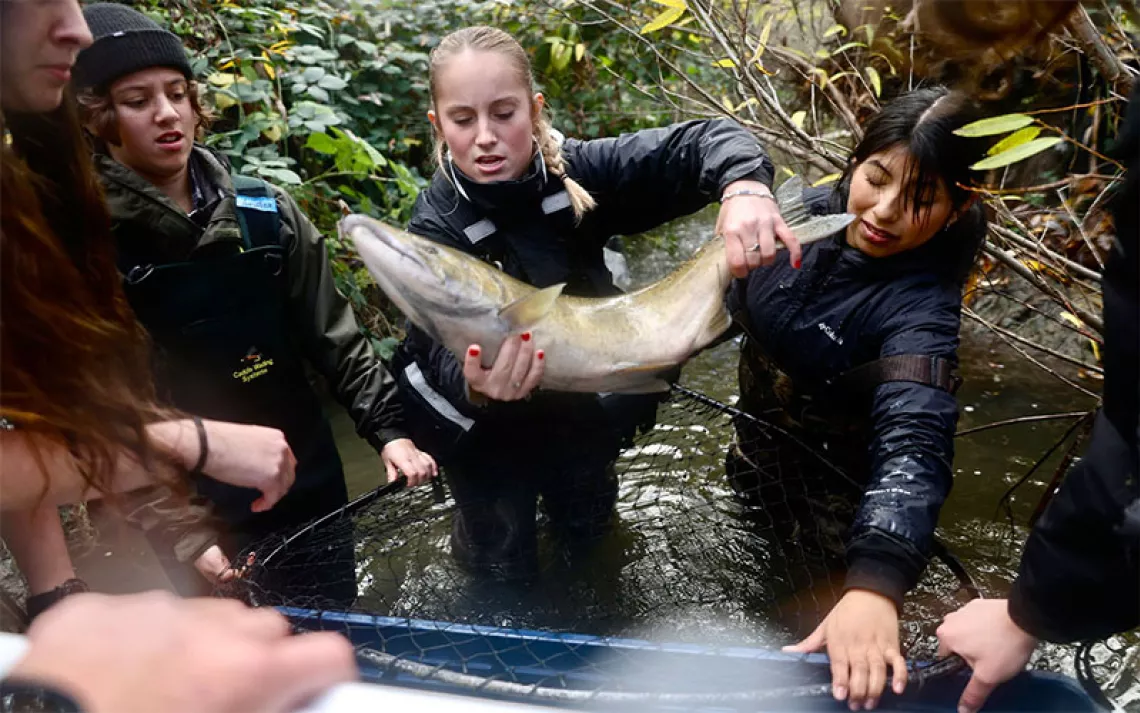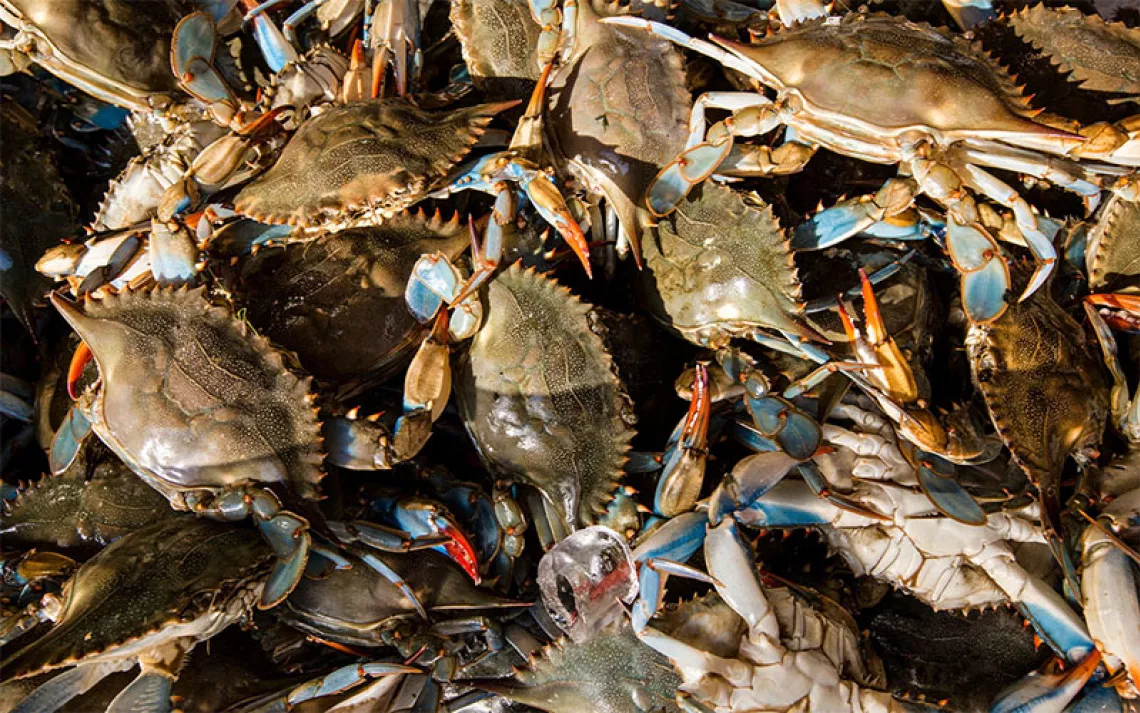The Secrets Stored Within Seaweed
New tools are helping scientists restore healthy ocean ecosystems
It is low tide at Half Moon Bay. The tide pools are emerging. Soon, sea stars, hermit crabs, octopuses, limpets, and mussels become visible in the rocky intertidal habitat. And everywhere, there is seaweed. Emily Miller remembers tidepooling here with her mother when she was little and loving it. She never knew just how much information she was going to unlock from the seaweed when she got older.
Now a research technician at California's Monterey Bay Aquarium Research Institute (MBARI), Miller is the primary author of a study published in June that shows how mining information from the sometimes-centuries-old tissues of pressed seaweed or macroalgae can sharpen scientists’ understanding of historical oceanic conditions, dating as far back as the 1870s. “Seaweed has always appealed to me as a study system because it is so accessible,” Miller told Sierra. “You don’t have to go out on a boat or dive to collect it; it's right there at the ocean's shore. You just need to wait for a low tide, and everything is revealed to you.” In 2017, researchers with Monterey Bay Aquarium formed the Aquarium's Ocean Memory Lab. That's when they began to view their herbarium collections of pressed, dried seaweed, and algae as “snapshots through time going back in history.”
That’s because the objective of the Ocean Memory Lab was to extend marine biologists’ baselines—that’s an initial measurement of a condition that scientists use for points of comparison to gauge changes. And baselines that go back further in time better equip marine conservationists to understand long-term changes in ocean health, and thus can better inform ocean management practices.
Today, marine biologists study the ocean and record their observations using sophisticated tools that range from satellites and drones to buoys and even autonomous underwater vehicles. However, these are all recent additions to their recording arsenal, and according to Kyle Van Houtan, chief scientist at the Monterey Bay Aquarium, most existing ocean data only goes back to the 1950s at the earliest. “That's simply not enough data to have an informed baseline of what's normal in the ocean, of what ocean health should be,” he says. “But marine life like turtles, corals, seabirds, and macroalgae are essentially biological drones that record their own ecosystem experience in their tissues.”
Similar studies have found that tree rings store information about rainfall across millennia, that corals can record the history of increasing ocean acidification over time in their structures, and that animal muscle tissue and blood document both what those animals have eaten and their prey community in their area at that time.
For this particular macroalgae study, MBA researchers analyzed pressed seaweed samples from herbarium collections dating back to 1878. Before they analyzed these specimens, however, the researchers had to ensure that the herbarium paper on which the seaweed was preserved had no impact on its makeup. To that end, Miller and colleagues first collected and preserved fresh specimens from the three major groups of algae—red, brown, and green—that were well represented in the Monterey Bay area through time. They then repeatedly analyzed them throughout the course of a year to make sure that they could interpret the historical specimens just as they would if they were collected in the present day. They also found that some species were more consistent according to certain metrics (like the presence of heavy metals and amino acid composition). With that knowledge, they eventually selected a genus called Gelidium—the branching red algae—and, when they started analyzing herbaria specimens, used several different species from within that genus as baseline measures.
For years prior to this study, scientists used the Bakun Upwelling Index to measure the strength of upwelling—that’s the movement of nutrient-rich cool ocean water to the surface, due to winds—in Monterey Bay. But the index only measured recent activity. Thanks to the MBARI study, however, scientists can now hindcast the Bakun Upwelling Index seven decades, so as to measure ocean upwelling between 1878 and 1945.
“When we expect there to be strong upwelling, we also expect there to then be a high rate of growth in the seaweeds in that time,” Miller explains. This is significant because upwellings—which provide seaweeds with the nutrients they need to grow—set the productivity regime for the Monterey Bay ecosystem and the entire coast of California. A strong or weak upwelling has repercussions across the food chain, all the way up to giant whales, and of course, also impacts fishing activities.
Newfound hindcasting abilities also boosted researchers’ understanding of the fluctuations between sardine- and anchovy-dominated ocean ecosystems. For instance, a decrease in upwelling in the 1940s caused the peak in sardine catch for the Monterey canneries. Then, toward the end of the 1940s and into the '50s, when upwelling started to increase, the bay became anchovy-dominated, prompting a crash in sardine fishery. While the phenomenon is well documented, the additional upwelling data shows the extent to which environmental conditions played a large role in the change.
Improved understanding of such shifts in the ecosystem can better inform fishery management practices in that scientists can encourage practices that respond to these upswelling cycles. “Some of these cycles, like the sardine-anchovy regime shifts, are multidecade cycles, so a longer data set can show us some of these patterns that we couldn’t see before,” says Miller. “There may be even longer cycles that happen in the ocean ecosystem that would be revealed by having a longer data set and an earlier baseline.”
Miller believes that different types of macroalgae could be used to document various aspects of oceanic conditions. Brown algae, for instance, can show changes in the level of heavy metals (like arsenic) in water. Rockweeds, which are very slow-growing, might be able to record longer-term ocean changes in just one individual. The ulva, a sea lettuce, grows when conditions are just right and dies back with winter storms, but it can record the period from spring to fall in any given year. Examining the amino acid composition in seaweeds can provide a means to track the increase in a human population over time, based on how much wastewater they’re releasing into the system.
According to Van Houtan, scientists are just scratching the surface of possibilities with this study. He says other upwelling-driven systems along the West Coast, from Mexico to Canada, can now be studied in the same vein. He adds that its findings could also provide significant opportunities for scientists to determine optimal nutrient regimes for coral reefs—which are threatened by environmental changes like ocean acidification, warming, and nutrient pollution—and estuarine ecosystems across the planet. They could also inform how we manage the waste water that is treated and pumped out into oceans—as waste water’s chemicals add nutrients to the water, which can choke algae’s growth (causing algal blooms) and significantly impact coral.
What it ultimately boils down to: If more scientists could look back to herbaria collections to determine historically optimal levels of nutrients in a given system, they could work toward those levels again. A 2015 study linked nutrient runoff to a decline in some fish populations in Monterey Bay, and especially in Elkhorn Slough, a seven-mile-long tidal estuary north of Monterey. While the nearby San Francisco Bay has yet to experience similar effects of nutrient excess, like algal blooms and fish kills (resulting from low concentrations of dissolved oxygen in the water), evidence suggests its capacity to absorb these nutrients without negative impacts might be decreasing. “If we can find out what healthy levels of phosphorus and nitrogen looked like for these systems before human intervention, we could manage them and build toward that target over time,” says Van Houtan. Studies to that end are urgent, given that the San Francisco Bay is home to over 1,000 species of animals and supports over 130 species of fish.
And much of the information we need to that end is readily available within algae. Natural history museums around the world exist as repositories of information that can come in many other forms. Archives of fish, corals, sea bird feathers, turtle shells, whale bones, and even otter fur all store vitally important information in their tissues. As long as you know what it is you’re looking for, the data stored in these historic specimens is just waiting to be unlocked.
 The Magazine of The Sierra Club
The Magazine of The Sierra Club




